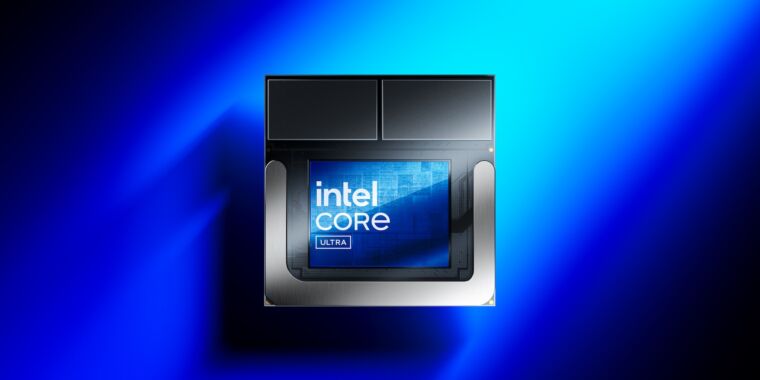Intel
Intel has formally announced its first batch of next-generation Core Ultra processors, codenamed “Lunar Lake.” The CPUs will be available in PCs beginning on September 24.
Formally dubbed “Intel Core Ultra (Series 2),” these CPUs follow up the Meteor Lake Core Ultra CPUs that Intel has been shipping all year. They promise modest CPU performance increases alongside big power efficiency and battery life improvements, much faster graphics performance, and a new neural processing engine (NPU) that will meet Microsoft’s requirements for Copilot+ PCs that use local rather than cloud processing for generative AI and machine-learning features.
Intel Core Ultra 200V
Intel
The most significant numbers in today’s update are actually about battery life: Intel compared a Lunar Lake system and a Snapdragon X Elite system from the “same OEM” using the “same chassis” and the same-sized 55 WHr battery. In the Procyon Office Productivity test, the Intel system lasted longer, though the Qualcomm system lasted longer on a Microsoft Teams call.
If Intel’s Lunar Lake laptops can match or even get close to Qualcomm’s battery life, it will be a big deal for Intel; as the company repeatedly stresses in its slide deck, x86 PCs don’t have the lingering app, game, and driver compatibility problems that Arm-powered Windows systems still do. If Intel can improve its battery life more quickly than Microsoft, and if Arm chipmakers and app developers can improve software compatibility, some of the current best arguments in favor of buying an Arm PC will go away.
-
Intel is trying to fight back against Qualcomm’s battery life advantage in Windows PCs.
Intel -
Many of Lunar Lake’s changes were done in service of reducing power use.
Intel -
Here, Intel claims a larger advantage in battery life against both Qualcomm and AMD, though there are lots of variables that determine battery life, and we’ll need to see more real-world testing to back these numbers up.
Intel
Intel detailed many other Lunar Lake changes earlier this summer when it announced high-level performance numbers for the CPU, GPU, and NPU.
Like Meteor Lake, the Lunar Lake processors are a collection of silicon chiplets (also called “tiles”) fused into one large chip using Intel’s Foveros packaging technology. The big difference is that there are fewer functional tiles—two, instead of four, not counting the blank “filler tile” or the base tile that ties them all together—and that both of those tiles are now being manufactured at Intel competitor TSMC, rather than using a mix of TSMC and Intel manufacturing processes as Meteor Lake did.
Intel also said it would be shipping Core Ultra CPUs with the system RAM integrated into the CPU package, which Apple also does for its M-series Mac processors; Intel says this will save quite a bit of power relative to external RAM soldered to the laptop’s motherboard.
Keep that change in mind when looking at the list of initial Core Ultra 200V-series processors Intel is announcing today. There are technically nine separate CPU models here, but because memory is integrated into the CPU package, Intel is counting the 16GB and 32GB versions of the same processor as two separate model numbers. The exception is the Core Ultra 9 288V, which is only available with 32GB of memory.

